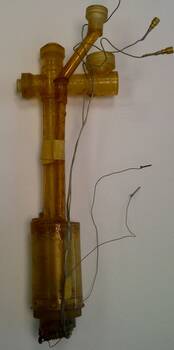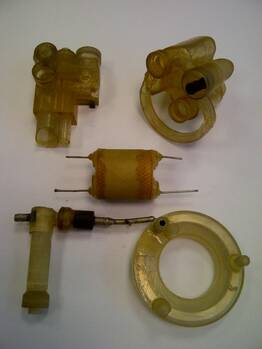wiki:bolts_nuts
Table of Contents
Low temperature Bolts&Nuts
This is the place to find some information about “How to…?”
Attaching objects: glues, tapes, threads
Glues
- Stycast® 1266 or “transparent stycast” is a very fluid epoxy, 2-component glue. Used to glue plastic parts (cells, rods, etc). Can be used to cast rods.
- Stycast® 2850 FT or “black stycast” is a very viscous(“tyxotropic”) epoxy, 2-component glue used to make seals, feed-throughs, etc. due to its thermal expansion coefficient, intermediate between that of metals and plastics.
- Araldite® is an epoxy, 2-component glue. Used to glue plastic parts (cells, rods, etc). Can be used to cast rods used to make plastic parts for dilution refrigerators (mixing chambers, plugs, etc). Source: CRTBT-CNRS cryogenics lab. An example of a plastic mixing chamber (G. Frossati, Grenoble 1977) made out of Araldite is shown in the picture.
- UV-curing glues: used by dentists, these glues can be a good solution to glue rapidly wires and other delicate parts. Used in Grenoble in the 80's. Source: H. Godfrin
- Pattex® Neoprene glue: Gluing masks, shields, etc. on the vacuum can, 1K shield, etc. can be easily made using Neoprene glues (for instance Pattex®. The method has been used for decades at the ILL, where Cadmium masks are glued onto the cryostat vessels, adapted to each experimental geometry. It is possible to remove the glued parts after the experiment. Source: ILL cryogenics lab.
Tapes
- Micropore 3M Tape®: Electrical wires must be attached to different parts of the cryostat in order to limit vibrations and noise. Masking tape has been traditionally used, but it tends to become dry, rigid, brittle, and hard to remove. I started using in the 80's the so-called “Micropore 3M tape” (for medical applications, available in pharmacies), the results were excellent. It holds well on different surfaces. Ultra-thin wires can be kept in place without problems. It is easy to remove even after years. Easy to write on it (labels on thin wires). Source: H. Godfrin
Plastic cells, mixing chambers, Plugs
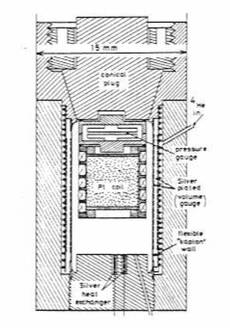
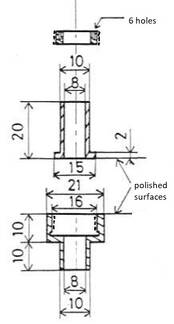 Plastic cells and mixing chambers are commonly found in low temperature refrigerators, in particular when magnetic fields are present.
Plastic cells and mixing chambers are commonly found in low temperature refrigerators, in particular when magnetic fields are present.
- J. Wheatley and A.C. Mota designed dismountable plastic (Epibond 100A) and metallic plugs sealed with a mixture of soap and glycerin: A Convenient and Reliable Demountable Seal for Low Temperature Work, A. C. Mota, Review of Scientific Instruments 42, 1541 (1971). https://doi.org/10.1063/1.1684935
- Conical plugs in Araldite cells, sealed with Apiezon N vacuum grease, have been designed and extensively used by Frossati. In small sizes (about 1 to 2 cm, the conical plugs withstand pressures differences of about 40 bar. Diameters of 4 to 6 cm have been used at low pressures (mixing chambers). Both parts of the cone (plug and seat) have to be machined using the same angle, essentially made at the same time.
- Flat Araldite plugs: for low pressure applications (<2 bars pressure difference), a modified version has been used by Godfrin. The principle is identical to Frossati's plug described above, but the flat surfaces are easily reproducible. One of the surfaces, the “lip”, is thin and flexible, and adjusts to the opposite surface.
Radiation shields
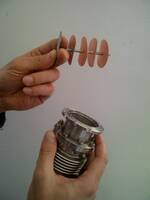 A common problem in home-made refrigerators is insufficient shielding in pumping lines. A simple design for removable radiation shields is shown in the picture.
A common problem in home-made refrigerators is insufficient shielding in pumping lines. A simple design for removable radiation shields is shown in the picture.
Leaks
- Leaks in Indium-sealed aluminum flanges: We have found a difficult leak type in a vacuum can made out of aluminum (neutron scattering cryostat). The can was made in two sections, connected by bolted flanges, with an indium O-ring seal. A growing leak appeared after about 10 years. After many unsuccessful tests, the surface of the flange was machined gently, and the leak was gone. The leak was probably located in the thin oxide layer of the aluminum flange. This could lead to a severe aging problem in machines using aluminum flanges. Source: H. Godfrin, DRILL cryostat, CNRS-ILL.
wiki/bolts_nuts.txt · Last modified: 2022/01/30 18:36 by henri.godfrin@neel.cnrs.fr

